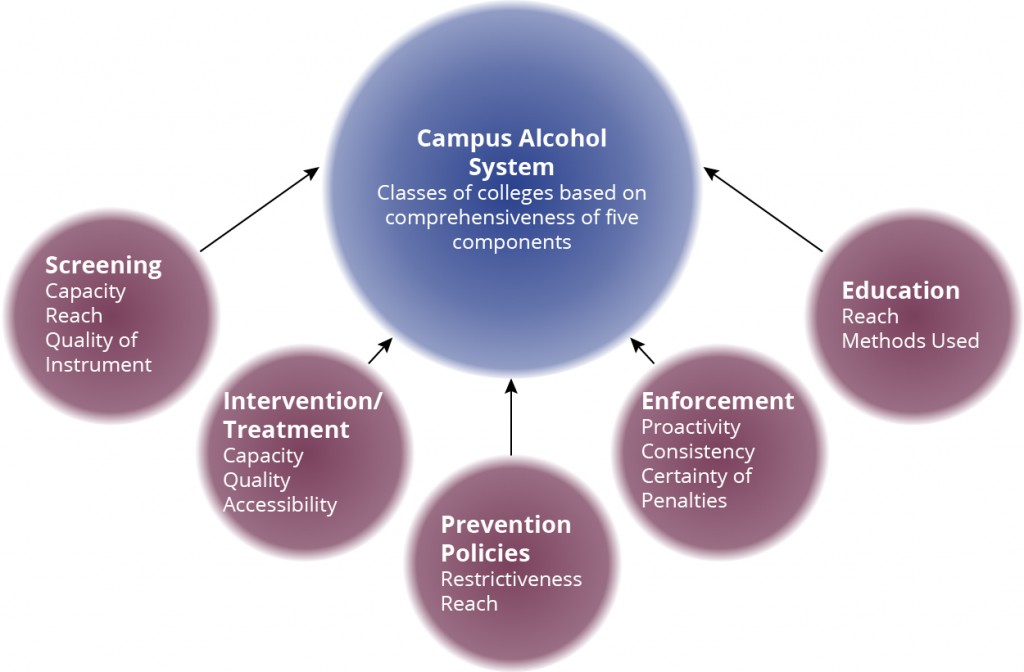ADDRESSING STUDENT ALCOHOL USE AND RELATED PROBLEMS
A significant amount of research has been conducted on the prevalence and effects of single programs and policies on college campuses related to alcohol treatment, intervention, and prevention. To be effective at reaching the entire continuum of students who may experience alcohol-related problems, campuses must do more than implement single policies or programs. Components of a comprehensive campus alcohol system include alcohol screening, intervention, treatment, prevention policy and enforcement. Recent research suggests that making multiple changes to the campus and community alcohol environment can be effective in reducing alcohol use and related problems among college students; however, the ideal combination of programs, policies and other systems changes has not been identified. See the CollegeAIM matrix developed by the National Institute on Alcohol Abuse and Alcoholism.

ASSESSING COLLEGE SYSTEMS
To assess college alcohol systems across the U.S., we surveyed campus leaders at four-year colleges. We assessed the college alcohol systems across five domains: screening, treatment/intervention, policy, enforcement and education using latent class analysis (LCA). The LCA identified patterns of responses across survey participants for the five components and created classes or groups of colleges that exhibited similar patterns of responses. See the publications below for more information.

Campus Systems Model was created in 2007 as part of Assessing Comprehensiveness and Quality of Alcohol Screening, Treatment, and Prevention Systems for Young Adults within Educational Systems, funded by the Robert Wood Johnson Foundation’s Substance Abuse Policy Research Program (RWJF #63118). Traci Toomey, Principal Investigator; Darin Erickson, Toben Nelson and Ken Winters, Co-Investigators.
See the following published articles for research pertaining to this project (request here):
Toomey TL, Nelson TF, Winters KC, Miazga MJ, Lenk KM, Erickson DJ. Characterizing college systems for addressing student alcohol use: Latent class analysis of U.S. four-year colleges. Journal of Studies on Alcohol and Drugs, 74(5):777-786, 2013.
Lenk KM, Erickson DJ, Winters KC, Nelson TF, Toomey TL. Screening services for alcohol misuse and abuse at four-year colleges in the U.S. Journal of Substance Abuse Treatment. 43(3):352-358, 2012.
Lenk KM, Erickson DJ, Nelson TF, Winters KC, Toomey TL. Alcohol policies and practices among four-year colleges in the U.S.: Prevalence and patterns. Journal of Studies on Alcohol and Drugs, 73(3):361-367, 2012.
Toomey TL, Miazga M, Lenk KM, Erickson DJ, Winters KC, Nelson TF. Enforcing alcohol policies on college campuses: Reports from college enforcement officials. Journal of Drug Education. 41(3):327-344, 2011
Winters KC, Toomey TL, Nelson TF, Erickson DJ, Lenk KM, Miazga M. Screening for alcohol problems among 4-year colleges and universities. Journal of American College Health, 59(5):350-357, 2011.
Nelson TF, Toomey TL, Lenk KL, Erickson DJ, KM, Winters KC. Implementation of NIAAA College Drinking Task Force Recommendations: How are colleges doing 6 years later? Alcoholism: Clinical & Experimental Research, 34(10):1687-1693, 2010.
ALCOHOL SCREENING TOOLS FOR USE WITH COLLEGE STUDENTS
Colleges addressing problem alcohol use among their students need a systematic screening process to accurately identify students who may benefit from alcohol intervention or treatment services. Screening on a college campus can be a relatively brief and simple process implemented by a range of campus professionals.
A number of psychometrically-sound screening tools are available to identify alcohol problems among adolescents and young adults, including college problem drinkers. Several studies have assessed the quality and appropriateness of these tools, and we reviewed these studies to determine the best alcohol screening tools for college students. Our conclusions and recommendations are summarized below.
Note: Table and text excerpted from Winters KC, Toomey TL, Nelson TF, Erickson DJ, Lenk, KM, Miazga, M. Screening for alcohol problems among 4-year colleges and universities. Journal of American College Health, 59(5):350-357, 2011.
Evaluation of Formal Alcohol Screening Tools for College Students
| SCREENING TOOL | PSYCHOMETRICALLY EVALUATED IN COLLEGE SAMPLE? | COMPARATIVE EVALUATION FAVORABLE?1 | RECOMMENDED2 |
|---|---|---|---|
| CAGE | Yes | Noa | |
| AUDIT | Yes | Yes | ✅ |
| SASSI | Yes | Nob | |
| MAST | Yes | Noa | |
| CRAFFT | No3 | Yes | |
| CUGE | Yes | Yes | ✅ |
| PESQ | Yes | Nob | |
| GAIN-Screen | No | Nob | |
| RAPI | Yes | Nob | |
| DAST | No | Nob | |
| CAPS | Yes | Yes | ✅ |
| RAPS | Yes | Yes | ✅ |
1Yes = empirically compared to at least one other tool and at least one study showed the tool to be psychometrically more favorable than the other tool(s).
Noa = empirically compared to at least one other screening tool and no study showed the tool to be psychometrically more favorable than the other tool(s).
Nob= not empirically compared to other screening tools.
2 Those checked as “recommended” based on the tool having been both psychometrically tested in a college sample and faired well in a comparative evaluation.
3The CRAFFT has been evaluated among older adolescents (18-20-year-olds) treated in Emergency Departments.